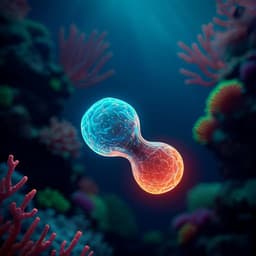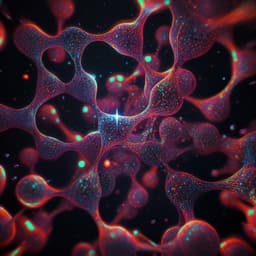
Medicine and Health
Biosynthesized Silver Nanoparticle (AgNP) From *Pandanus odorifer* Leaf Extract Exhibits Anti-metastasis and Anti-biofilm Potentials
A. Hussain, M. F. Alajmi, et al.
Discover how innovative silver nanoparticles synthesized from *Pandanus odorifer* leaf extract showcase remarkable anti-cancer and antimicrobial properties. This groundbreaking research, conducted by Afzal Hussain and colleagues, offers promising insights into addressing cancer and bacterial infections.
Playback language: English
Introduction
Cancer is a leading cause of global mortality due to challenges in early diagnosis, lack of specificity in treatments, and severe side effects of existing chemotherapeutic drugs. The compromised immune systems of cancer patients undergoing chemotherapy increase susceptibility to secondary infections caused by various pathogens. This necessitates the development of new therapeutic strategies that effectively address both cancer and associated infections. Silver nanoparticles (AgNPs) have emerged as promising antimicrobial and anticancer agents due to their unique properties. However, conventional AgNP synthesis methods often involve toxic chemicals, prompting the exploration of eco-friendly biosynthesis approaches using plant extracts. This research investigated the synthesis of AgNPs using *Pandanus odorifer* leaf extract, a readily available and cost-effective resource known to contain flavonoids and phenolic compounds, which can act as reducing and stabilizing agents in nanoparticle synthesis. The study aimed to evaluate the anti-cancer and anti-biofilm properties of these biosynthesized AgNPs, exploring their potential as a dual-action therapeutic agent against cancer and secondary bacterial infections.
Literature Review
Extensive research has demonstrated the antimicrobial properties of silver nanoparticles against a wide range of bacterial pathogens, including both Gram-positive and Gram-negative strains. The mechanism of action involves interaction with bacterial cell membranes, leading to disruption of cellular functions and ultimately cell death. In addition, several studies have explored the anticancer potential of AgNPs, highlighting their ability to inhibit cancer cell proliferation, induce apoptosis, and suppress metastasis. The mechanism behind this anticancer activity often involves generation of reactive oxygen species (ROS), which cause oxidative stress and damage cellular components within cancerous cells. However, the efficacy and toxicity of AgNPs vary depending on factors such as particle size, shape, and surface functionalization. The use of plant extracts in AgNP synthesis offers several advantages over conventional chemical methods, including reduced toxicity and improved biocompatibility. Plant extracts provide a natural source of reducing and capping agents, reducing the need for hazardous chemicals and promoting the formation of stable nanoparticles with controlled properties. This approach aligns with the principles of green chemistry and sustainability. The *Pandanus odorifer* plant has been reported to possess various medicinal properties, with its leaves containing a rich array of bioactive compounds.
Methodology
This study involved a multi-stage process:
**Stage I: Synthesis of AgNPs:**
1. *Pandanus odorifer* leaves were crushed, dissolved in distilled water (5g/100mL), and extracted using a speed extractor at 50°C for 42 minutes to obtain the plant extract (POLE).
2. The POLE (50 mg/mL) was used to synthesize AgNPs via a microwave irradiation-assisted method. Optimized reaction conditions were determined by varying AgNO3 concentration (2-10 mM), POLE concentration (1-5 mL), pH (5-8), and incubation time (0-30 min). The final synthesis involved adding 5 mL of 8 mM AgNO3 to 5 mL of 50 mg/mL POLE at pH 8.0, followed by microwave irradiation (90 s at 900 W, 2450 MHz). A conventional synthesis method (4h incubation without microwave) served as a control.
**Stage II: Characterization of AgNPs:**
1. UV-Vis spectrophotometry (300-800 nm) assessed the optical properties and determined the characteristic absorption peak of AgNPs.
2. X-ray diffraction (XRD) determined the crystalline structure and phase purity of the AgNPs.
3. Fourier-transform infrared spectroscopy (FTIR) analyzed functional groups present in the POLE and capped AgNPs.
4. Surface-enhanced Raman spectroscopy (SERS) provided further evidence for POLE capping on the AgNPs surface.
5. High-resolution transmission electron microscopy (HRTEM) determined the morphology, size, and stability of the AgNPs.
**Stage III: Biological Evaluation:**
1. **Cytotoxicity:** The cytotoxicity of AgNPs on rat basophilic leukemia (RBL) cells was assessed using the MTT (3-(4,5-dimethylthiazol-2-yl)-2,5-diphenyltetrazolium bromide) assay, measuring cell metabolic activity and determining the IC50 value.
2. **Anti-metastasis:** The in vitro scratch assay evaluated the effect of AgNPs on RBL cell migration and cell-cell interactions.
3. **Antimicrobial activity:** Minimum inhibitory concentrations (MICs) of AgNPs against various Gram-positive and Gram-negative bacterial strains were determined using the micro-broth dilution method. Sub-MICs were used for subsequent assays.
4. **Anti-quorum sensing (QS):** Violacein production by *Chromobacterium violaceum* was used to assess anti-QS activity.
5. **Anti-biofilm:** Exopolysaccharide (EPS) and alginate production were measured to evaluate the anti-biofilm potential. Swarming motility was also examined. Biofilm formation was further quantified using a crystal violet staining assay.
6. **In vivo toxicity:** Acute toxicity and effects on liver and kidney function were assessed in mice following intraperitoneal injection of AgNPs (1 and 2 mg/kg). Liver and kidney function markers (ALT, AST, urea, creatinine) were measured, and the comet assay evaluated DNA damage in liver and kidney cells.
Key Findings
The study successfully biosynthesized AgNPs using *Pandanus odorifer* leaf extract. UV-Vis spectroscopy confirmed the formation of AgNPs with a characteristic absorption peak around 435 nm. XRD analysis revealed a highly crystalline structure with a face-centered cubic (FCC) structure. FTIR and SERS studies confirmed the capping of POLE on the AgNPs. HRTEM showed uniformly dispersed AgNPs with sizes ranging from 5 to 9 nm, exhibiting long-term stability. The AgNPs demonstrated significant cytotoxic effects on RBL cells (IC50 = 3.40 µg/mL) and inhibited cell migration in the scratch assay. Antimicrobial activity was demonstrated with MIC values between 4 and 16 µg/mL against various bacterial strains. At sub-MIC concentrations, AgNPs showed significant anti-quorum sensing activity, reducing violacein production by 89.6% at 4 µg/mL and alginate production by 75.6% at 8 µg/mL. EPS production was also significantly reduced in both Gram-positive and Gram-negative bacteria (61–84% reduction). Swarming motility was suppressed (32-76% reduction). Biofilm formation was significantly inhibited in all tested bacterial strains (12–87% reduction). The *in vivo* study in mice showed that the AgNPs were well-tolerated at the tested doses (1 and 2 mg/kg), with no significant toxicity observed. Liver and kidney function markers showed improvements compared to the positive control group. The comet assay showed a reduction in DNA damage in liver and kidney cells after treatment with AgNPs. Molecular docking studies indicated interactions of AgNPs with key enzymes involved in quorum sensing in *Pseudomonas aeruginosa*.
Discussion
The findings of this study demonstrate the successful biosynthesis of stable, well-characterized AgNPs using a sustainable and eco-friendly approach. The significant anti-cancer and anti-biofilm activities exhibited by these AgNPs highlight their potential as a novel therapeutic agent against cancer and associated infections. The dual-action mechanism, involving anti-metastasis effects and broad-spectrum antimicrobial properties, provides a promising strategy for managing cancer and mitigating the risk of secondary infections. The *in vivo* tolerability of the AgNPs suggests a favorable safety profile. The mechanistic insights gained from molecular docking studies provide a foundation for further investigations into the interaction between AgNPs and bacterial quorum sensing systems. This study contributes to the growing body of research on green nanotechnology and its potential applications in healthcare. The results warrant further preclinical studies to optimize the dosage and formulation for clinical applications and to explore potential synergistic effects when used in combination with conventional cancer therapies and antibiotics.
Conclusion
This research successfully synthesized silver nanoparticles using a green synthesis approach employing *Pandanus odorifer* leaf extract. These AgNPs showed promising anti-cancer and anti-biofilm activity *in vitro* and *in vivo*, with good tolerability. Their potential for treating cancer and associated infections is significant, justifying further investigation into their clinical efficacy. Future studies should focus on optimizing the AgNP formulation for improved delivery and efficacy, exploring their synergistic effects with existing treatments, and conducting more comprehensive toxicological studies to fully assess their safety profile before clinical translation.
Limitations
The study primarily focused on *in vitro* and acute *in vivo* toxicity assessments, limiting the long-term toxicity evaluation. The study used a single cancer cell line (RBL) which might not represent the diversity of cancer cells, limiting the generalizability of anti-cancer findings. A wider range of bacterial strains and clinical isolates could further validate the antimicrobial properties and anti-biofilm potential. The molecular docking studies provided predictions of interactions and require further validation through experimental techniques. More comprehensive pharmacokinetic and pharmacodynamic studies are needed to evaluate absorption, distribution, metabolism, and excretion of AgNPs in vivo to inform optimal therapeutic strategies.
Related Publications
Explore these studies to deepen your understanding of the subject.







